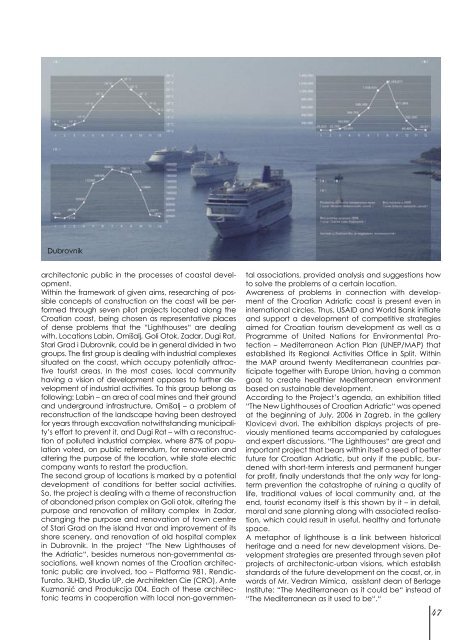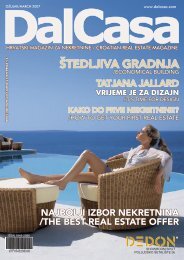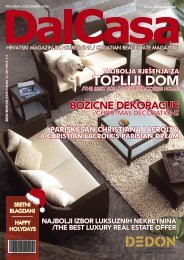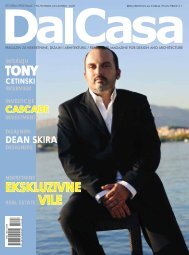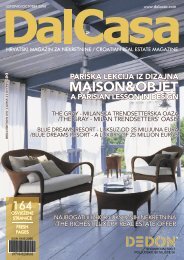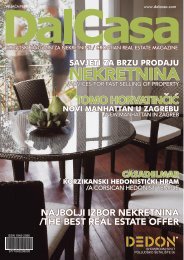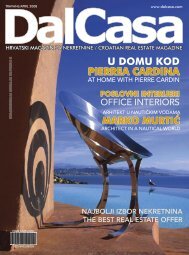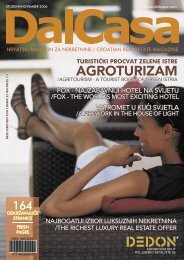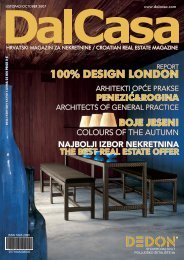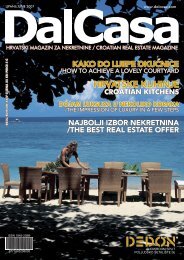BUSINESS ARCHITECTURE POSLOVNA ARHITEKTURA - DalCasa
BUSINESS ARCHITECTURE POSLOVNA ARHITEKTURA - DalCasa
BUSINESS ARCHITECTURE POSLOVNA ARHITEKTURA - DalCasa
You also want an ePaper? Increase the reach of your titles
YUMPU automatically turns print PDFs into web optimized ePapers that Google loves.
Dubrovnikarchitectonic public in the processes of coastal development.Within the framework of given aims, researching of possibleconcepts of construction on the coast will be performedthrough seven pilot projects located along theCroatian coast, being chosen as representative placesof dense problems that the “Lighthouses“ are dealingwith. Locations Labin, Omišalj, Goli Otok, Zadar, Dugi Rat,Stari Grad i Dubrovnik, could be in general divided in twogroups. The first group is dealing with industrial complexessituated on the coast, which occupy potentially attractivetourist areas. In the most cases, local communityhaving a vision of development opposes to further developmentof industrial activities. To this group belong asfollowing: Labin – an area of coal mines and their groundand underground infrastructure, Omišalj – a problem ofreconstruction of the landscape having been destroyedfor years through excavation notwithstanding municipality’seffort to prevent it, and Dugi Rat – with a reconstructionof polluted industrial complex, where 87% of populationvoted, on public referendum, for renovation andaltering the purpose of the location, while state electriccompany wants to restart the production.The second group of locations is marked by a potentialdevelopment of conditions for better social activities.So, the project is dealing with a theme of reconstructionof abandoned prison complex on Goli otok, altering thepurpose and renovation of military complex in Zadar,changing the purpose and renovation of town centreof Stari Grad on the island Hvar and improvement of itsshore scenery, and renovation of old hospital complexin Dubrovnik. In the project “The New Lighthouses ofthe Adriatic“, besides numerous non-governmental associations,well known names of the Croatian architectonicpublic are involved, too – Platforma 981, Rendic-Turato. 3LHD, Studio UP, de Architekten Cie (CRO), AnteKuzmanić and Produkcija 004. Each of these architectonicteams in cooperation with local non-governmentalassociations, provided analysis and suggestions howto solve the problems of a certain location.Awareness of problems in connection with developmentof the Croatian Adriatic coast is present even ininternational circles. Thus, USAID and World Bank initiateand support a development of competitive strategiesaimed for Croatian tourism development as well as aProgramme of United Nations for Environmental Protection– Mediterranean Action Plan (UNEP/MAP) thatestablished its Regional Activities Office in Split. Withinthe MAP around twenty Mediterranean countries participatetogether with Europe Union, having a commongoal to create healthier Mediterranean environmentbased on sustainable development.According to the Project’s agenda, an exhibition titled“The New Lighthouses of Croatian Adriatic“ was openedat the beginning of July, 2006 in Zagreb, in the galleryKlovicevi dvori. The exhibition displays projects of previouslymentioned teams accompanied by cataloguesand expert discussions. “The Lighthouses“ are great andimportant project that bears within itself a seed of betterfuture for Croatian Adriatic, but only if the public, burdenedwith short-term interests and permanent hungerfor profit, finally understands that the only way for longtermprevention the catastrophe of ruining a quality oflife, traditional values of local community and, at theend, tourist economy itself is this shown by it – in detail,moral and sane planning along with associated realisation,which could result in useful, healthy and fortunatespace.A metaphor of lighthouse is a link between historicalheritage and a need for new development visions. Developmentstrategies are presented through seven pilotprojects of architectonic-urban visions, which establishstandards of the future development on the coast, or, inwords of Mr. Vedran Mimica, assistant dean of BerlageInstitute: “The Mediterranean as it could be“ instead of“The Mediterranean as it used to be“.“47


